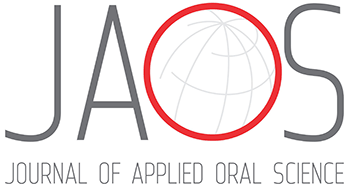Abstract
Objectives
One of the plausible mechanisms in the relationship between periodontitis and coronary artery disease (CAD) is the systemic inflammatory burden comprised of circulating cytokines/mediators related to periodontitis. This study aims to test the hypothesis that periodontal inflamed surface area (PISA) is correlated with higher circulating levels of acute phase reactants (APR) and pro-inflammatory cytokines/mediators and lower anti-inflammatory cytokines/mediators in CAD patients.
Material and Methods
Patients aged from 30 to 75 years who underwent coronary angiography with CAD suspicion were included. Clinical periodontal parameters (probing depth - PD, clinical attachment loss, and bleeding on probing - BOP) were previously recorded and participants were divided into four groups after coronary angiography: Group 1: CAD (+) with periodontitis (n=20); Group 2: CAD (+) without periodontitis (n=20); Group 3: CAD (-) with periodontitis (n=21); Group 4: CAD (-) without periodontitis (n = 16). Serum interleukin (IL) −1, −6, −10, tumor necrosis factor (TNF)-α, serum amyloid A (SAA), pentraxin (PTX) 3, and high-sensitivity C-reactive protein (hs-CRP) levels were measured with ELISA.
Results
Groups 1 and 3 showed periodontal parameter values higher than Groups 2 and 4 (p<0.0125). None of the investigated serum parameters were statistically significantly different between the study groups (p>0.0125). In CAD (-) groups (Groups 3 and 4), PISA has shown positive correlations with PTX3 and SAA (p<0.05). Age was found to predict CAD significantly according to the results of the multivariate regression analysis (Odds Ratio: 1.17; 95% Confidence Interval: 1.08-1.27; p<0.001).
Conclusions
Although age was found to predict CAD significantly, the positive correlations between PISA and APR in CAD (-) groups deserve further attention, which might depend on the higher PISA values of periodontitis patients. In further studies conducted in a larger population, the stratification of age groups would provide us more accurate results.
Keywords
Periodontitis; Acute phase proteins; Coronary artery disease; Inflammation
